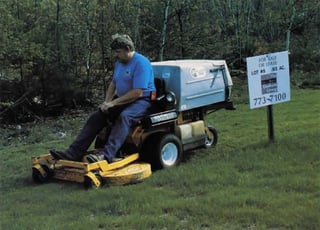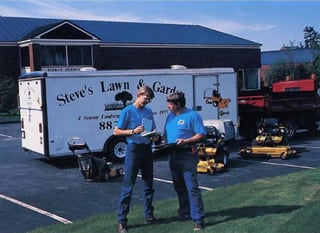Steve Bennet took his first close look at a Walker mower in 1987. But in his own words he "had some concerns." At the time the mower was relatively new to the industry and it was getting touch and most of his competitors used walkers. Nate encouraged his father to make the competitive connection back in 1994, and, two years later, the company now operates three Walkers, two 20-hp grasshandling models and a 16-hp model with a side-discharge deck.
 Seven years is a long time to wait for a mower. Even then, on his first mowing job Steve wasn't convinced he had made the right decision. In a letter to Walker distributor George O. Hayes & Sons, he describes his first trip to the field, "I took the Walker to my largest commercial account, and immediately became intimidated and frustrated with the mower as I found the zero turn feature, the rear steer, the front mount mower, the quick response and overall speed of the mower much different to the riding tractor I was used to. I managed to finish mowing and trimming the property (92,000 sq ft) in about 5 hours. I loaded up to go home, feeling as though I had made a very serious mistake, when I realized that it usually took two people, using a riding tractor, two trim mowers and two string trimmers, 3-4 hours to complete what I had done in five hours alone. Plus I had not used a trim mower, and had done little string trimming."
Seven years is a long time to wait for a mower. Even then, on his first mowing job Steve wasn't convinced he had made the right decision. In a letter to Walker distributor George O. Hayes & Sons, he describes his first trip to the field, "I took the Walker to my largest commercial account, and immediately became intimidated and frustrated with the mower as I found the zero turn feature, the rear steer, the front mount mower, the quick response and overall speed of the mower much different to the riding tractor I was used to. I managed to finish mowing and trimming the property (92,000 sq ft) in about 5 hours. I loaded up to go home, feeling as though I had made a very serious mistake, when I realized that it usually took two people, using a riding tractor, two trim mowers and two string trimmers, 3-4 hours to complete what I had done in five hours alone. Plus I had not used a trim mower, and had done little string trimming."
Steve continues, "By the end of the 1994 season, my son and I found we had reduced our mowing times by as much as 50 percent on the properties we maintained."
Since that rather dubious start, the Bennetts have not only added more mowers to their equipment lineup, they've added attachments, too, including two de-thatchers, an angle broom, a single-stage snowthrower and a bed edger. They even apply lime and fertilizer with a spreader designed by Walker distributor George Hayes of Bethel, Maine. All of the attachments help get the chores done in less time.
Roller Coaster Ride
Steve and Nate operate Steve's Lawn and Garden in Scarborough, Maine, not far from Portland. Between the two of them and one employee, sometimes two, they mow approximately 50 properties. Nate runs the mowing crew while Steve, an "on-call" fireman for the town, concentrates on small installation projects. The mix contributed $150,000 to the revenue rolls last year.
The figure is modest compared to what Steve used to generate during his company's heyday. In business since 1971, first in maintenance and then more heavily in construction and installation, Steve, by the mid 80s, had grown the company to 13 employees strong. Unfortunately, the bust that swept the construction industry in New England forced Steve to reconfigure the business. He downsized the installation side and picked up more maintenance accounts. Despite the restructuring, his interest started to wane, until Nate's arrival full time a few years later.
Today, the company generates 80 percent of its revenue from maintenance, the remainder from installation projects. The customer mix is 60 percent residential and 40 percent commercial and includes some of the nicest looking properties around the city.
 Thanks in part to the tough years, Steve appreciates the term profitability now more than ever. Most, if not all, of his maintenance properties - both commercial and residential - are within a three mile radius of his home. And he's a stickler on price. He knows how much it costs to do a job profitably. As he puts it, "I won't work just to have the work."
Thanks in part to the tough years, Steve appreciates the term profitability now more than ever. Most, if not all, of his maintenance properties - both commercial and residential - are within a three mile radius of his home. And he's a stickler on price. He knows how much it costs to do a job profitably. As he puts it, "I won't work just to have the work."
"Stubborn he may be, but thrifty he's not," says Steve about himself while mimicking native lore. After all, he recently purchased a 20-ft enclosed trailer to haul around his mowers and decks. It also doubles as a work shop/storage facility and rolling advertisement. This Maine native also owns a skidsteer loader and backhoe for installation jobs and a couple of dump trucks to haul away grass clippings.
All of his equipment, including his Walkers and their attachments, have a healthy return on-investment (ROI) ratio. He claims the mowers alone allowed the company to expand its weekly mowing last year to 600,000 sq ft, an increase of 38 percent from 1994, without having to hire extra personnel. This year, he is maintaining 850,000 sq ft of lawn, again with the same number of employees. It takes Nate and another operator 4 to 4 1/2 days to complete the mowing cycle. Saturday is a make-up day. Steve is available to help, too, if mowing gets behind, although he says his son hesitates to call him in on prime accounts because "I don't keep a straight enough line."
Both father and son also emphasize the key role that attachments for their Walkers have played in the company's recent growth. The bed edger, for example, has trimmed edging time in half, to the extent there are only a couple of properties where they still edge with a handheld edger. Steve applauds the snowblower and power broom attachment for their yeoman work on sidewalks during the tough New England winters, not to forget the dethatchers for spring cleanup and the spreader for quick and easy lime and fertilizer application.
"It's unbelievable how many uses there are for the Walkers and their attachments," says Nate. "Each application saves time and money." More significantly, they have helped Steve and his son keep their prices in line and maintain their competitive edge.
No, the mowers and attachments haven't made the Bennett's business; they've just helped make their business more competitive.




 Site Search
Site Search



